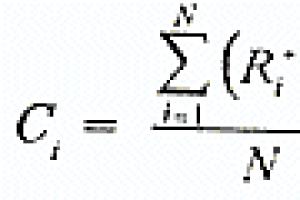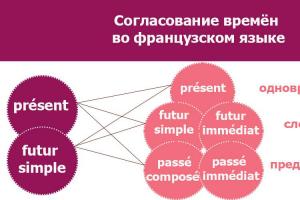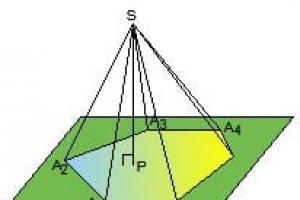Teacher's comments on the material being studied
You may encounter the following difficulties while completing the task.
| Possible difficulties | Good advice |
| What to do if it seems that several answer options are suitable for the missing sentence? | If the first sentence is missing in the task, use the following tips. The first sentence usually sets the topic of the text. Even more precisely, the topic of the text is set in the second part of the first sentence, closer to its ending. Look at the answer options from this perspective. Find the ending of the sentence, the content of which is revealed in further text. |
| What to do if it is difficult to find the place where the missing sentence should be in the text? | If the task is not missing the first sentence, then use the next hint. Look for semantic inconsistencies between sentences in the text. To do this, carefully observe how the author’s thought develops in the text. Determine the topic of the text, find out whether all the arguments correspond to the thesis of the topic? Most likely, the missing sentence should stand in the place of the semantic inconsistency found. |
Ways to connect sentences in a text
The sentences in the text are connected in meaning. This connection manifests itself at the lexical and grammatical levels of the language, see: section Means of connecting sentences in the text.
There are two main ways of connecting sentences in a text: serial (chain) connection and parallel connection.
| Communication method | The essence of the method |
|
| Serial (chain) communication | Finally, Plyushkin appears on the pages of the poem, a man who is not only devoid of any positive qualities, but has almost lost his human appearance. He seems like a man caught in a catastrophe, running wild on some desert island. The disaster turned his once prosperous estate into ruins, his house looks like a dump, his clothes are “a complete hole.” | In the first sentence, the semantic emphasis falls on the characterization of Plyushkin. In the second sentence, this information becomes the basis for a new message (Plyushkin looks like a person who was in a disaster). The basis for the message in the third sentence is the information in the second sentence. Let us explain the essence of a chain connection with a diagram. |
| Parallel communication | The deeper moral decline of man is demonstrated by the image of Sobakevich. Sobakevich is unfriendly, greedy and rude. He is a fist, that is, he knows how to squeeze his benefit out of everything, without being embarrassed by the dubiousness of the deal. He seems to be a fraudster: for profit he is even ready to resort to blackmail. | In the first sentence, the semantic emphasis falls on the characterization of Sobakevich. This information becomes the subject of characterization in the remaining sentences. Let us explain the essence of parallel communication with a circuit.
|
In speech practice, both main methods are often combined.
Oral and written speech. Text. Semantic integrity of the text
Language exists in two types of speech: oral and written. With the help of spoken language, people directly communicate with each other. Oral speech is live, spontaneous and unprepared communication in real time, and the composition of this communication depends entirely on the specific situation. Communication through written speech, on the contrary, is always prepared in advance and is built taking into account the possible time distance between those communicating. Therefore, the author of a written message is interested in ensuring that it is holistic both from the point of view of topic, and from the point of view of meaning, and from the point of view of composition, that is, it would be a text in the proper sense of the word.
Text (lat. textum - fabric, plexus, connection) is a sequence of sentences related in meaning and grammatically, created with the aim of characterizing (revealing) a certain topic. When we use the word text, we basically mean something written. It should not be forgotten that there are genres that, as a rule, exist in oral form, but are prepared as written texts (for example, a report or lecture).
The semantic integrity of the text is associated with several concepts:
2) topic of the text;
3) the main idea of the text;
4) disclosure of the topic of the text;
The topic of the text is the subject or phenomenon that is the focus of the author’s attention. The author’s efforts are aimed at characterizing the topic and revealing the theme of the text.
The main idea of the text is the general characteristic given to the topic in the text.
The main idea can sometimes be directly expressed in the text, and sometimes inferred from its content.
The topic is revealed through a series of interconnected judgments, each of which directly or indirectly characterizes the topic. These judgments can, in turn, have a variety of topics. Particular themes that arise as the main one is revealed are called micro-themes. Taking into account microtopics is necessary to derive the main idea of the text.
Position (point of view) of the author. By choosing the topic of the text and revealing it with the help of certain micro-themes, the author of the text clarifies for the reader his value position regarding the topic and main idea of the text. He directly or indirectly expresses his own assessment of the theses of the text and the phenomena reflected in it.
In a complex syntactic whole, there are two main types of connection between independent sentences:
1. Chain (serial) connection.
2. Parallel communication.
With a chain connection we have a complex syntactic whole of heterogeneous composition, with a parallel connection - homogeneous. With a chain connection, independent sentences are synsemantic, with a parallel connection, they are autosemantic. The analysis shows that the chain connection is more frequent.
Characteristics of types of interphrase connections in a complex syntactic whole.
1. Chain connection in a complex syntactic whole.
In a chain connection, instead of one of the independent words of the previous sentence, either a pronoun or a synonym is used in the subsequent sentence, or this word is repeated. The structural feature of a chain connection of sentences in a complex syntactic whole is the beginning.
The main types of beginning in a complex syntactic whole with a chain connection:
1. Dynamic beginning (for example, Everything is mixed up in the Oblonskys’ house).
2. Nominative themes (eg, Moscow...How much has merged in this sound for the Russian heart).
3. Beginnings with the initial verb are (eg, There are women in Russian villages...).
4. Temporary beginnings (for example, Years passed, a rebellious impulse of thought dispelled previous dreams).
The chain connection itself is represented by three varieties (this connection is similar to sequential subordination in a complex sentence with several subordinate clauses).
Varieties of chain connection in a complex syntactic whole:
1. The most widespread is the pronominal chain connection. (Pronouns are special substitute words, “ambulance of the Russian language,” according to L.Ya. Malovitsky).
For example, the next day at the appointed time I was already standing behind the stacks, waiting for the enemy. Soon he appeared.
2. Chain synonymous connection. To connect sentences in a complex syntactic whole, text synonyms and functional equivalents are used.
For example, Pushkin is the sun of our literature. He is the creator of the Russian literary language. The great poet left us a legacy of wonderful examples of artistic speech (text synonyms).
3. Communication based on lexical repetition.
For example, leaving the Kalitins, Lavretsky met with Panshin; they bowed coldly to each other. Lavretsky went to his apartment and locked himself in.
Thus, with a chain connection, sentences of heterogeneous composition are combined, synsemantic, that is, closely welded sentences, which, being isolated, are deprived of the ability to be used independently, since they have lexico-grammatical indicators of connection with previous sentences.
2. Parallel connection in a complex syntactic whole.
This type of communication is less common. Sentences with this type of connection in a complex syntactic whole of homogeneous composition are autosemantic, that is, more structurally and semantically independent.
For example, a book is a repository of knowledge. The book is a repository of all the great experiences of mankind. A book is an inexhaustible source of high aesthetic pleasure.
As we see, with a parallel connection, sentences are not linked to one another, but are compared or contrasted. Depending on the nature of parallelism, certain types of complex syntactic integers with parallel connections are distinguished:
1. Actually parallel type.
All sentences as part of a complex syntactic whole are constructed in parallel, that is, according to the same structural scheme (example above).
2. Anaphoric complex syntactic wholes (same beginning - semantic, sound, syntactic).
3. Epiphoric complex syntactic wholes (parallelism is expressed in epiphora - ending).
4. Ring complex syntactic wholes (parallelism in the same beginning and ending).
Parallel communication is more complex than chain communication and is more difficult to detect in the text. It is also stylistically more significant, since it is based on stylistic figures of speech: anaphora, epiphora, parallelism, etc. Widely used in journalism.
There is no sharply defined boundary between parallel and chain connections. They both can be presented in combination.
In some literature, a paragraph is attributed the same properties as a complex syntactic whole. The difference is this: unity of theme, content, and semantic completeness are not characteristic of a paragraph. A paragraph can consist of one sentence, but a complex syntactic whole cannot. These are units of different levels.
A complex syntactic whole is a structural and semantic unit, and a paragraph is a stylistic and compositional device, a kind of punctuation mark. A paragraph is a more subjective authorial principle, since the author’s attitude to what is being presented is expressed through the paragraph.
“A paragraph is a red line, an indent at the beginning of the line and a segment of written speech from one red line to another” (R. N. Popov).
5. Paragraph as a compositional and semantic unit of text. Functions of beginning and ending paragraphs.
A paragraph is the portion of text between two indents, or red lines. A paragraph differs from a complex syntactic whole in that it is not a unit of the syntactic level. A paragraph is a means of dividing a coherent text on a compositional and stylistic basis.
Paragraph They are considered sometimes a syntactic unit, sometimes a logical, sometimes a stylistic unit. For A.M. Peshkovsky, for example, a paragraph is an intonation-syntactic unit. L.M. Losev and M.P. Senkevich considers the paragraph to be a semantic-stylistic category. For A.G. Rudneva is a syntactic unit. The latter seems completely unacceptable.
The internal essence of a paragraph is best understood by comparing it with interphrase unity (a complex syntactic whole). These are units that are somewhat similar in appearance, but not essentially identical. Complex syntactic whole- this is a theme-rhematic sequence that opens with an opening phrase (or a core phrase that contains the content of the whole). It is the beginning phrases of complex wholes, when pulled together, that form the meaningful outline of the text. The paragraph may not have a beginning as such. The core phrase of a paragraph (the main one in thematic, logical, content terms) can stand at the beginning of the paragraph, at the end of the paragraph, or itself act as a separate paragraph. Moreover, a paragraph may have several core phrases if it is large in volume and contains a number of topic-rhematic sequences. A paragraph and a SSC are units of different levels of division, since the bases for their organization are different (a paragraph does not have a special syntactic design, unlike a complex syntactic whole), however, these are units that intersect, functionally touching, since both of them play a semantic-stylistic role. That is why the paragraph and the SSC can, in their particular manifestations, coincide and correspond to each other. Since a paragraph can emphasize the emotional and expressive qualities of a text, it can break a single STS. This is especially true of literary texts, in contrast to scientific ones, where there are much more coincidences between the STS and the paragraph, since they are entirely focused on the logical organization of speech. The boundaries of the paragraph and the SSC may not coincide: one sentence can be included in a paragraph.
Types of thematic (classic) paragraph from a construction point of view. Analytical-synthetic paragraph contains an analytical part (explanatory, explanatory) in the first position, and a generalizing, final part in the second. Synthetic-analytical paragraph begins with a generalizing, core phrase, the meaning of which is revealed in subsequent messages. Frame paragraph has a combined structure: the beginning outlines the topic, then comes the explanatory part, and the paragraph ends with a generalizing phrase. The first and last statements overlap lexically, and thus the topic is “closed.” The main functions of paragraph division are as follows: logical-semantic, expressive-emotional, accentual. The functions of a paragraph in dialogical and monologue speech are different: in a dialogue, a paragraph serves to distinguish the remarks of different persons, i.e. performs a purely formal role; in monologue speech - to highlight compositionally significant parts of the text (both from the point of view of logical-semantic and emotional-expressive). The functions of a paragraph are closely related to the functional and stylistic affiliation of the text and its stylistic coloring; at the same time, they also reflect the individual author’s peculiarities of text design. In particular, the average length of paragraphs often depends on the writing style.
Sentences in a text can be connected in three different ways: connecting, sequential (also known as chain) and parallel. The latter is most often used in texts of descriptive and narrative type; it is also called centralized, since they have the same subject of relations, which makes it possible to compare texts with a parallel connection of sentences with complex sentences, in which the subordinate parts relate to the main one according to the same principle .
Parallel way of connecting sentences: characteristic features
The most typical structure of a text with parallel communication looks like this. The first thought is the opening thought, which represents the main thesis of the text. This thought is followed by several sentences that reveal it - they are combined into a series and this phenomenon is called syntactic parallelism. These sentences are parallel in their structure and the predicates in them are expressed in a single form.
Such a text ends with an ending in which there is no parallelism, usually the time plan changes. Having analyzed a text with such a connection, it is easy to identify the features characteristic of all sentences and find parts of the same type.
Sentences that are connected by a parallel connection are relatively independent - for example, they depend less on the context than with a chain connection. Their content is also completely independent.
A text with a parallel connection of sentences suggests an interesting rhythmic pattern. And parallelism is an excellent basis for many stylistic figures. So. parallelism presupposes not only comparison, but also opposition.
It will help to better understand everything that has been said by considering an example of parallel connection of sentences.
“He sat for a long time on the shore of the lake. The stars looked into the water, admiring themselves. The humid air settled on the grass and fallen leaves, covering everything with a droplet haze. The lights of the distant city barely flickered, appearing like a scattering of fireflies. It smelled of warmth and tenderness.”
Having examined this test, you will notice that all sentences follow the same structure - They begin with a subject, followed by a predicate expressed by a verb in the past tense.
The parallel syntactic connection between sentences in a text is often strengthened by anaphora, that is, the repetition of the first word in each syntactic unit (or even an entire expression).
For example:“What is a man if not an animal? What is happiness if not living according to your instincts? What is society if not something that limits free will? What is the world if not a place to be enjoyed?”
Thus, determining the parallel method of syntactic connection is not too difficult: if the text is descriptive or narrative, you need to look at the structure of the sentences; if it has characteristic common features, then find the subject to which all three sentences can relate. The coincidence of all three features indicates that there is a parallel connection between the sentences.
What have we learned?
The parallel connection of sentences in the text requires compliance with several rules. First, they all relate to one subject (usually this is a thesis thought, which is revealed in sentences with a parallel connection). Second, they are identical or very similar in structure. And third, the text is usually of a narrative or descriptive type. In some cases, these signs are enhanced by anaphora. At the same time, both in content and contextually, sentences in a text with a parallel connection are usually quite independent.
Based on the nature of the connection between sentences, all texts can be divided into three types:
- texts with chain links;
- texts with parallel connections;
- texts with connecting links.
Chain (serial, linear) communication, perhaps the most common way of connecting sentences (cf. sequential connection of subordinate clauses in a complex sentence). The widespread use of chain connections in all styles of speech is explained by the fact that they best correspond to the specifics of thinking and the peculiarities of connecting judgments. Where thought develops linearly, sequentially, where each subsequent sentence develops the previous one, as if following from it, chain connections are inevitable.
Among the various types of chain communication, according to the method of expression, the most widespread are:
- pronominal connections (nouns, adjectives, numerals are replaced in the subsequent sentence by pronouns and pronominal adverbs);
- lexical and syntactic repetitions;
- synonymous replacements.
As an example, let us give an excerpt from the story of I.S. Turgenev "District Doctor":
One autumn, on the way back from the field I had left, I caught a cold and fell ill. Fortunately, the fever caught me in the county town, in a hotel; I sent for the doctor. Half an hour later the district doctor appeared, a short man, thin and black-haired. He prescribed me the usual diaphoretic, ordered me to put on a mustard plaster, very deftly slipped a five-ruble note under his cuff, and, however, coughed dryly and looked to the side, and was just about to go home, but somehow got into conversation and stayed.
When constructing this text, each subsequent sentence develops the previous one, and the most significant information in the previous sentence is repeated by various means in the subsequent one, becoming the basis for the introduction of new information. And this new information is repeated again in the next sentence, becoming the basis for the next new information.
So, the first sentence: One day in the fall, on the way back from the field I had left, I caught a cold and fell ill.- can be divided into two parts according to the type of information transmitted. First, a description of the general situation is given ( one autumn, on the way back from the departing field), and then - the most significant part in terms of meaning, characterizing what, in fact, happened ( I caught a cold and was sick). In the second sentence: Fortunately, the fever caught me in the county town, in a hotel; I sent for the doctor- this information is repeated. Noun ( fever) correlates with information conveyed earlier by verbs of the same thematic series ( caught a cold and fell ill). What is new in this sentence and therefore most significant is the information that the narrator sent for the doctor. In the following sentence: Half an hour later the district doctor appeared, a short man, thin and black-haired.- this information is repeated again (for this a synonymous replacement is used: doctor → doctor), and what is new is the doctor's description. This is followed again by a reference to the previous text (for this purpose the pronoun is used He), and the doctor’s actions and behavior are reported as new information.
Chain connections are very characteristic of business, scientific, and journalistic speech, that is, they are present wherever there is a linear, sequential, chain development of thought.
In texts from parallel (centralized) communication Sentences that are related in meaning usually have the same subject (cf. complex sentences with a parallel connection of subordinate clauses). Naming actions, events, phenomena located nearby (adjacent), parallel connections by their very nature are intended for description and narration.
The most typical structure for texts with parallel communication is the following. First comes the beginning, containing the idea-thesis of the entire text. Then follows a series of sentences that reveal this idea, and the syntactic features of these sentences are:
- parallelism of their structure;
- unity of forms of expression of predicates.
Only at the end is a change in the time plan and the absence of parallelism usually allowed.
As an example, consider an excerpt from the story of I.S. Turgenev “Khor and Kalinich”, in which the author gives a comparative description of his heroes:
The two friends were not at all alike. Khor was a positive, practical man, an administrative head, a rationalist; Kalinich, on the contrary, belonged to the number of idealists, romantics, enthusiastic and dreamy people. Khor understood reality, that is: he settled down, saved up some money, got along with the master and other authorities; Kalinich walked in bast shoes and managed to get by somehow. The polecat bred a large family, obedient and unanimous; Kalinich once had a wife, whom he was afraid of, but he had no children at all. Khor saw right through Mr. Polutykin; Kalinich was in awe of his master. Khor loved Kalinich and provided him with protection; Kalinich loved and respected Khor... Khor spoke little, chuckled and reasoned to himself; Kalinich explained himself eagerly, although he did not sing like a nightingale, like a lively factory man...
The first sentence is the opening thesis: The two friends were not at all alike. Each following sentence contains a contrast between Khor and Kalinich (there are two subjects here, but they are united into one whole in the beginning - both friends) on any basis, and this opposition is given through a system of parallel structures. The parallelism of structures is manifested, in particular, in the fact that the sentences are complex non-union constructions, the first part of which characterizes Khor, the second - Kalinich, and their names, repeating, open each part. This is usually followed by a group of predicates, and all verbs are in the past tense, usually of the imperfect form: was, belonged, understood, got along, walked, was in awe etc. Since the purpose of the description is to prove the complete opposite of the characters’ characters, I.S. Turgenev uses a system of parallel contextual antonyms: a practical person, an administrative head, a rationalist - an idealist, a romantic, an enthusiastic and dreamy person; understood reality, settled down, saved up some money - walked around in bast shoes, managed to get by somehow; he bred a large family - there were no children at all; saw right through Mr. Polutykin - was in awe of Mr. etc. Thus, narrative contexts reveal closely related phenomena.
The third type of connection between independent sentences is accession. This is a principle of constructing a statement in which part of it in the form of separate, additional information is attached to the main message, for example: Ephraim’s wife was reputed to be an intelligent woman - and not without reason(Turgenev); There's no need for me to make excuses and it’s not in my rules (Chekhov).
Connecting structures usually contain additional information - by association, in the form of an explanation, comment, etc. They imitate live speech with its ease, naturalness, etc. G.A. Solganik in his textbook “Text Stylistics” cites an excerpt from an essay by K.I. as a typical illustration of this type of connection. Chukovsky "Chekhov":
And to such an extent he was a team, choral person that he even dreamed of writing not alone, but together with others and was ready to invite the most unsuitable people to be his co-authors.
“Listen, Korolenko... We will work together. Let's write a drama. In four acts. In two weeks."
Although Korolenko never wrote any dramas and had nothing to do with the theater.
And to Bilibin: “Let's write a vaudeville in 2 acts together! Come up with the 1st action, and I’ll come up with the 2nd... The fee will be divided in half.”
And to Suvorin: “Let’s write a tragedy...”
And to him a few years later:
"Let's write two or three stories... You are the beginning, and I am the end."
note that accession, in contrast to chain and parallel connections, has a narrower application in text formation and is usually not capable of independently forming texts.
In addition, text, especially large ones, is usually not constructed using any one type of communication. As a rule, their combination is observed in the text depending on the specific author’s tasks.
To convey to others or themselves personally the meaning of what they want to say, people use text, which can be expressed in written or oral speech, out loud or mentally. It usually consists of several sentences that are related in meaning and grammar. Russian text in its structure may differ from the presentation and construction of sentences and phrases in other languages.
Text concept
Any text must carry a semantic load and have a clearly traceable narrative line. The topic of the text is what is being discussed. It is created to convey information on any selected topic, conveyed in the form of separate sentences united by a common semantic content.
Each subsequent sentence in the text can contain a micro-topic that helps reveal the general theme. In turn, a consistent presentation of the main idea reveals the idea of the text, that is, what it was created for.
The topic and idea of the text are always interconnected and form the content of the statement. The main idea can be expressed in one of the sentences or in the title. To make the text meaningful, there are ways to connect sentences.
In addition, each text has a clear structure and characteristics that define it as a linguistic unit.
Text features
To determine whether a statement is a text, you should know what is characteristic of it:
- Firstly, the text is always informative, therefore, whatever the types of connection of sentences, each new sentence serves to reveal the main topic, and not to repeat the same thing.
- Secondly, coherence, since each subsequent sentence is connected in meaning to the previous ones.
- Thirdly, integrity, which is created by the unity of the theme and main idea within the framework of the revealed content.
- Fourthly, the text has completeness, which occurs when the main idea is conveyed to the listener or reader.
- Fifthly, the text can always be “divided” into smaller parts, for example, paragraphs.
- Sixth, the text must relate to a situation, real or imagined, that the listener or reader can understand and understand.
Based on these features, you can determine whether the sentences are part of the text or are not related to each other in any way.
Text structure
In the work, sentences are connected to each other using:
- local connection, for example, by paragraphs;
- global connection, which consists in perceiving the meaning of the text as a whole;
- contact connection, when complementary sentences are nearby;
- distant communication, in which the components of speech are separated by explanatory parts of the text.
Another indicator of the text is its structure, which includes an introduction, a central part and a conclusion (conclusion).
Chain connection of sentences in the text
Methods of connecting sentences are divided into lexical, morphological, structural-semantic and syntactic levels. At the structural and semantic level, a distinction is made between chain and parallel types of communication. The chain connection between sentences suggests that each subsequent statement reveals the meaning of the previous one. This happens using:
- lexical repetition;
- synonyms;
- replacing words.
- The legend said that behind the high snowy mountain there was a beautiful city of abundance and happiness. There is no disease or poverty in that city, and eternal life awaits every resident. Eternal life without war, without hunger and old age forced brave souls to go in search of a mysterious city. Sentences are connected using lexical repetition, in which the main idea of the previous statement is revealed in the next one.

- I watched a new film. The comedy was really funny. In this type of connection, synonyms are used that replace each other: film - comedy.
- I read an interesting book. It took over my consciousness for the next few days. Sentences are linked by word substitution book on the pronoun she.
When replacing words, demonstrative and personal pronouns, pronominal adverbs and are most often used. Also, types of sentence connections such as verbal omission are often used, for example:
- It was getting dark. The first stars in the sky. Regardless of the omission of the word, the meaning of the text is clear and means that when evening falls, the first stars appear in the sky.
Parallel connections
The parallel connection of sentences in the text implies that they are completely independent and do not complement each other. With such a connection, they are either opposed, or compared with each other, or are a listing of something.
This type of connection corresponds to the same word order, and the members of the sentences have the same grammatical forms. Most often, parallel connection of sentences is used by authors to paint a more accurate picture of what is happening through description. Since each of the sentences in such a text is independent, they expand the “borders” of the event. This can manifest itself through various techniques.
Examples of means of connecting sentences in the text:
- The first rooster crow was heard. The sky in the east has brightened. There is only one star left in the sky. The morning of a new day has come. The identical beginning of each sentence unites them into a single text that conveys a description of the event - this is anaphoric parallelism.

- The first drops of rain fell on the asphalt. Passers-by began to take out umbrellas. In this case, the connection of sentences in the text is carried out by combining one phenomenon - rain - this is a logical type of connection.
- The car left the garage. The street was still empty and quiet. The sun was just rising over the city. Sentences of the same type are united by their juxtaposition.
A parallel connection of sentences in a text can be combined with a chain connection and form a parallel-chain sequence.
Parallel-chain connection
A parallel-chain connection is called when both of these types are used in the same text. In this case, the second sentence is connected with the first by a parallel connection, and the third is related to the second and is connected with it by a chain connection.
Examples using parallel-chain view:
- The most interesting was the chemistry room. What could be in the test tubes and flasks on the teacher's desk? What kind of portraits of great scientists and tables with incomprehensible icons hang on the wall - everything was new for the students who came here for the first time. The second and third sentences are connected by a chain connection using the same beginning, while the first and second are connected by a logical parallel connection.
- It got sharply cold outside. The mercury on the thermometer dropped below zero. It showed sub-zero temperatures, and this meant that winter was not going to give up so easily. The first and second sentences are independent, and they are united by one phenomenon - cold weather, while the third sentence is connected to the second by a chain connection using word substitution.

With this type of communication, there is a more complete disclosure of the described events or transfers.
Lexical connection of sentences
With the lexical type of connection between sentences, the Russian text is overloaded with repetition of the same or cognate words. This style of presentation of the text is characteristic of the official and business style, and in fiction - description. For example:
- Once upon a time there lived a grandfather and a woman. Grandfather and grandmother had no children.
- History is the science of human activities in the past. In the past, which existed before the appearance of Homo sapiens, and before the events that took place yesterday, everything becomes history.
The lexical connection of sentences also includes the replacement of words with synonyms or antonyms or their generic relationship. Examples of means of connecting sentences in the text:
- A fortress appeared on the horizon. The citadel became more and more formidable as it approached. Replacement using synonyms.

- One of the drawn matches turned out to be short. The other one is long. Antonyms are used.
Thus, sentences “cling” in the text with the help of lexical connections.
Syntactic means of communication
Moreover, the proposals are completely identical in their structure. This method is called for example:
- You need to be the best. You need to be better than yourself yesterday.
The juxtaposition of sentences (combining them into a single whole with the same typical meaning) is used in parallel communication, for example:
- Ducks and swans swam near the shore. There was complete silence as they waited for the next observer to throw pieces of bread into the waters of the lake. Vanity and hubbub began.

In syntactic communication, words are often used to hold sentences together in a single text: in this way, as stated above and the like.
Morphological means of communication
For morphological types of communication, the following are most often used:
- replacing nouns with pronouns - There are many trees in the forest. By which ones predominate, one can judge its composition. Nouns are replaced by pronouns.
- verbs of the same tense and aspect - Suddenly a gust of wind came. The umbrella was torn out of my hands. Passive verbs are in the past tense.

- particles and introductory words - He was wrong. Consequently, his friends did not support him.
Morphological connection is most often used in a descriptive or narrative nature.









